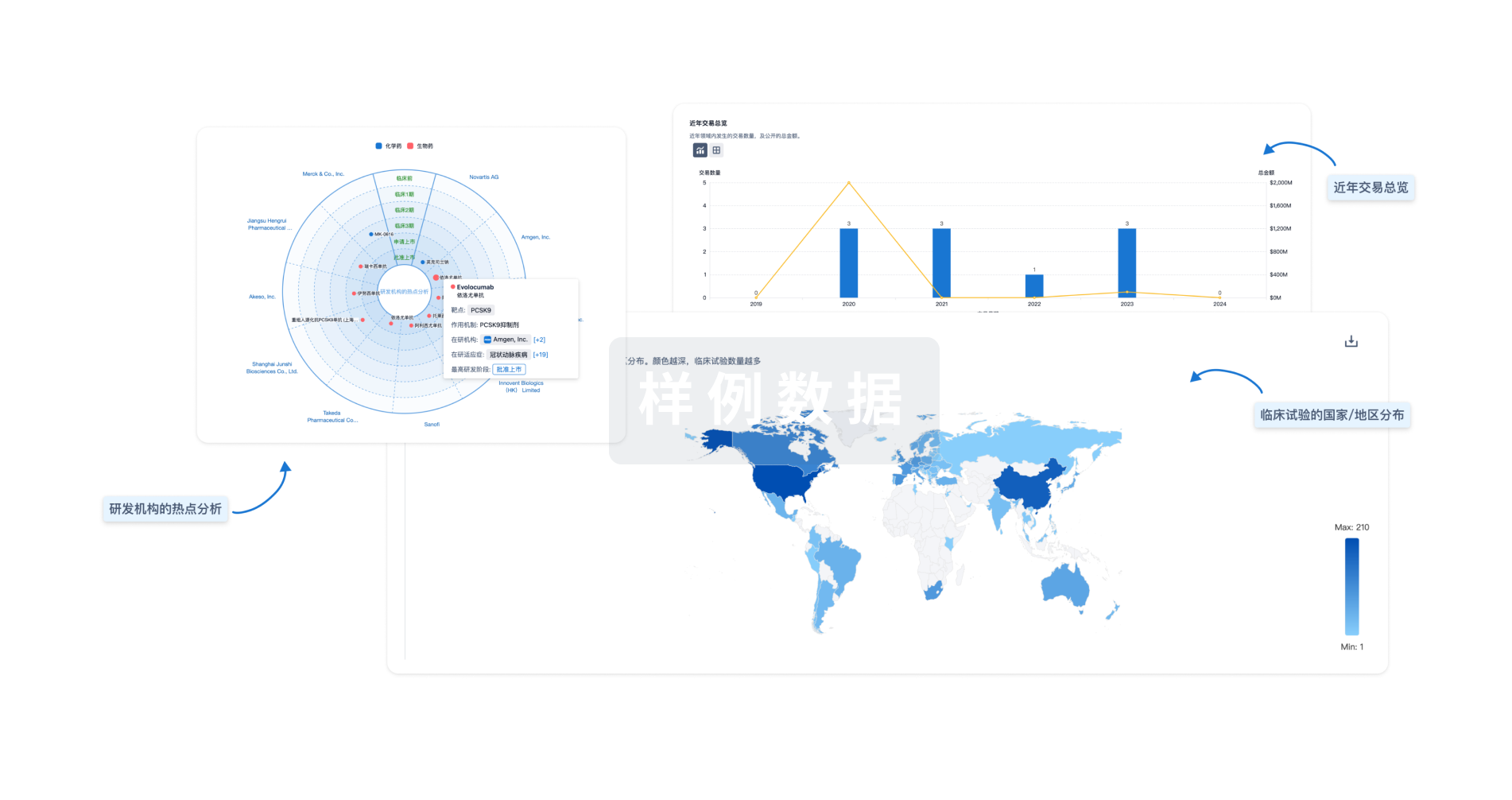预约演示
更新于:2025-05-07
MLH
更新于:2025-05-07
基本信息
别名- |
简介- |
关联
4
项与 MLH 相关的药物作用机制 HTT基因调节剂 [+1] |
在研适应症 |
非在研适应症- |
最高研发阶段临床2/3期 |
首次获批国家/地区- |
首次获批日期1800-01-20 |
靶点 |
作用机制 PMS2抑制剂 |
在研机构 |
原研机构 |
在研适应症 |
非在研适应症- |
最高研发阶段临床前 |
首次获批国家/地区- |
首次获批日期1800-01-20 |
靶点 |
作用机制 MLH1 modulators |
在研机构 |
原研机构 |
在研适应症 |
非在研适应症- |
最高研发阶段临床前 |
首次获批国家/地区- |
首次获批日期1800-01-20 |
4
项与 MLH 相关的临床试验NCT06873334
A Phase 2/3 Randomized, Double Blind, Placebo-Controlled, Dose Ranging Study to Evaluate the Pharmacodynamics, Safety and Efficacy of SKY-0515 in Participants With Huntington's Disease
The goal of this clinical trial is to test if the drug SKY-0515, an oral medication, can lower harmful proteins linked to Huntington's Disease (HD) and improve the symptoms of participants with HD.
This study includes men and women aged 25 and older who have HD confirmed by genetic testing and meet certain requirements for physical ability and independence.
This study includes men and women aged 25 and older who have HD confirmed by genetic testing and meet certain requirements for physical ability and independence.
开始日期2025-05-01 |
申办/合作机构 |
ACTRN12625000082404
An Open-Label, Crossover, Relative Bioavailability Study Comparing Tablet and Capsule Formulations of SKY-0515 in Healthy Volunteers
开始日期2025-03-10 |
申办/合作机构 |
ACTRN12624000602527
A Phase I Randomised, Double Blind, Placebo-Controlled, Single and Multiple Ascending Dose Study to Evaluate the Safety, Tolerability, Pharmacokinetics, Pharmacodynamics and Effect of Food on the Bioavailability of SKY-0515 in Healthy Volunteers and Patients with Huntington’s Disease
开始日期2024-07-12 |
申办/合作机构 |
100 项与 MLH 相关的临床结果
登录后查看更多信息
100 项与 MLH 相关的转化医学
登录后查看更多信息
0 项与 MLH 相关的专利(医药)
登录后查看更多信息
6,226
项与 MLH 相关的文献(医药)2025-09-01·Journal of Environmental Sciences
Mixture of arsenic and chromium alters antioxidant, DNA repair and tumor suppressor gene expressions in zebrafish brain at environmental concentrations
Article
作者: Dey, Koushik Kumar ; Chattopadhyay, Ansuman ; Kamila, Sreejata ; Islam, Shehnaz
2025-07-01·Modern Pathology
Lower Degree of Microsatellite Instability in Colorectal Carcinomas From MSH6-Associated Lynch Syndrome Patients
Article
作者: Kloor, Matthias ; Terlouw, Diantha ; van Wezel, Tom ; Bohaumilitzky, Lena ; von Knebel Doeberitz, Magnus ; Strobel, Fabian ; Morreau, Hans ; Nielsen, Maartje ; van der Werf-'t Lam, Anne-Sophie ; Helderman, Noah C ; Ahadova, Aysel
2025-06-01·Anti-Cancer Drugs
Long-term survival of an ALK fusion lung adenocarcinoma patient with high mutation burden and microsatellite instability high: a case report
Article
作者: Yang, Yanli ; Xu, Enwei ; Tong, Guoping ; Huo, Rujie ; Li, Shengshu ; Wei, Qin ; Zhai, Jinfang ; Chen, Yan ; Guo, Yanrong ; Han, Songyan ; Chen, Deyi
46
项与 MLH 相关的新闻(医药)2025-03-15
Skyhawk presents today on its novel SKY-0515 small molecule RNA splicing modulator targeting Huntington's Disease to members of the Huntington's Disease Youth Organization, at the annual HYDO International Congress in Prague, Czech Republic.
BOSTON, March 15, 2025 /PRNewswire/ -- Skyhawk Therapeutics, Inc., a clinical-stage biotechnology company developing novel small molecule therapies designed to modulate critical RNA targets, today presents on its novel SKY-0515 small molecule RNA splicing modulator targeting Huntington's Disease to members of the Huntington's Disease Youth Organization (HDYO), at the biannual HYDO International Congress in Prague, Czech Republic.
Continue Reading
SKY-0515 is Skyhawk's investigational small molecule RNA splicing modifier developed through the company's novel RNA-splicing platform. SKY-0515 is designed to reduce both HTT protein and PMS1 protein, an additional key driver of somatic CAG repeat expansion and HD pathology.
Skyhawk Presents at Huntington's Disease Youth Organization International Congress 2025
Post this
"We are excited to present on our Huntingtin-lowering clinical trials at the HDYO International Congress this month," said Sergey Paushkin, Chief Scientific Officer and Head of R&D at Skyhawk, "with positive results including SKY-0515's average HTT mRNA reduction of 72% at a daily oral dose of 9mg in trials thus far, and the drug's predicted suppression of the PMS1 protein, SKY-0515, if approved, could make a meaningful difference in Huntington's patients' lives."
Huntington's disease is a rare hereditary neurodegenerative disease affecting over 40,000 patients in the United States and many more worldwide. There are no approved treatments that can reverse or slow its course of progression.
"We are pleased with the speed at which we've conducted our studies thus far and are focused on this patient community in great need", said Bill Haney, Chief Executive Officer at Skyhawk. "SKY-0515's compelling results thus far demonstrate the immense potential of our platform to target indications for which there are no approved disease modifying therapies."
About Skyhawk Therapeutics
Skyhawk Therapeutics is a clinical-stage biotechnology company focused on the discovery and development of novel small molecule therapies designed to modulate critical RNA targets and revolutionize patient treatment for some of the world's most intractable diseases. Skyhawk's discovery expertise is rooted in its proprietary drug discovery platform, which assesses, identifies, and tests RNA splicing targets and small molecules across a broad range of therapeutic areas and disease states. Skyhawk has built collaborations with multiple pharma partners that leverage Skyhawk's novel platform across disease areas including neurodegenerative disease, autoimmune disease, and oncology. For more information visit .
Skyhawk Contact
Maura McCarthy
[email protected]
SOURCE Skyhawk Therapeutics
WANT YOUR COMPANY'S NEWS FEATURED ON PRNEWSWIRE.COM?
440k+
Newsrooms &
Influencers
9k+
Digital Media
Outlets
270k+
Journalists
Opted In
GET STARTED
siRNA临床结果
2025-03-09
2025年3月5日,第二军医大学(海军军医大学)/复旦大学/上海交通大学医学院附属仁济医院的研究团队在期刊《Nature Communications》上合作发表了题为“Pathogenic germline variants in Chinese pancreatic adenocarcinoma patients”的研究论文。
2025年3月5日,第二军医大学(海军军医大学)/复旦大学/上海交通大学医学院附属仁济医院的研究团队在期刊《Nature Communications》上合作发表了题为“Pathogenic germline variants in Chinese pancreatic adenocarcinoma patients”的研究论文。
https://www.nature.com/articles/s41467-025-57520-3
https://www.nature.com/articles/s41467-025-57520-3
这项研究通过高通量发现、实验验证和药物筛选的整合方法,揭示了中国PAAD患者的种系突变特征,并确定了具有功能和临床相关性的变异,为胰腺癌的风险评估和精准治疗提供了重要依据。
这项研究通过高通量发现、实验验证和药物筛选的整合方法,揭示了中国PAAD患者的种系突变特征,并确定了具有功能和临床相关性的变异,为胰腺癌的风险评估和精准治疗提供了重要依据。
01
01
研究背景
研究背景
遗传因素在PAAD的发病机制中起着至关重要的作用。有迹象表明,种系突变的频率和分布存在祖先差异。以往的研究大多集中在已知的致病基因上,包括BRCA1、BRCA2、ATM、PALB2、CDKN2A、MLH1、MSH2、STK11和TP5318。然而,对意义不确定变异(VUS)的研究却少得多,而这些变异却占PAAD相关基因变异的很大一部分。
遗传因素在PAAD的发病机制中起着至关重要的作用。有迹象表明,种系突变的频率和分布存在祖先差异。以往的研究大多集中在已知的致病基因上,包括BRCA1、BRCA2、ATM、PALB2、CDKN2A、MLH1、MSH2、STK11和TP5318。然而,对意义不确定变异(VUS)的研究却少得多,而这些变异却占PAAD相关基因变异的很大一部分。
02
02
针对致病种系突变的药物筛选
针对致病种系突变的药物筛选
为了确定PAAD的种系突变是否与药物反应的改变有关,研究人员利用患者衍生的三维类器官(PDO)培养物进行了药物敏感性筛选,并估计了药物敏感性与类器官基因组特征之间的相关性。作为阳性对照,携带BRCA2体细胞突变的DAC102、DAC58、DAC81、DAC85和DAC53有机体以及携带BRCA2种系突变的DAC4有机体对PARP抑制剂(奥拉帕尼)的反应最为明显。另外两个类器官(DAC76和DAC99)虽然没有BRCA1/2基因突变,但对奥拉帕尼也有疗效,不过DAC99存在ATM体细胞突变。一个携带KRAS p.G12C突变的类器官表现出对AMG510和MRTX849的敏感性,这两种药物在携带KRAS p.G12C突变的晚期实体瘤患者中都显示出良好的抗癌效果。这些结果凸显了通过PDO药物筛选进行个性化治疗评估的实用性。
为了确定PAAD的种系突变是否与药物反应的改变有关,研究人员利用患者衍生的三维类器官(PDO)培养物进行了药物敏感性筛选,并估计了药物敏感性与类器官基因组特征之间的相关性。作为阳性对照,携带BRCA2体细胞突变的DAC102、DAC58、DAC81、DAC85和DAC53有机体以及携带BRCA2种系突变的DAC4有机体对PARP抑制剂(奥拉帕尼)的反应最为明显。另外两个类器官(DAC76和DAC99)虽然没有BRCA1/2基因突变,但对奥拉帕尼也有疗效,不过DAC99存在ATM体细胞突变。一个携带KRAS p.G12C突变的类器官表现出对AMG510和MRTX849的敏感性,这两种药物在携带KRAS p.G12C突变的晚期实体瘤患者中都显示出良好的抗癌效果。
这些结果凸显了通过PDO药物筛选进行个性化治疗评估的实用性。
PAAD器官组织的药物敏感性特征。
PAAD器官组织的药物敏感性特征。
03
03
总结
总结
1. 种系突变的种族差异:
1. 种系突变的种族差异:
研究比较了亚洲和西方队列的种系突变情况,证实了种族和民族之间在胰腺癌种系突变中的显著差异。例如,2020年POLO III研究中非裔美国人的种系BRCA突变率最高(13.8%)。
研究比较了亚洲和西方队列的种系突变情况,证实了种族和民族之间在胰腺癌种系突变中的显著差异。例如,2020年POLO III研究中非裔美国人的种系BRCA突变率最高(13.8%)。
2. 关键基因的发现与功能验证:
研究确定了CFTR、BRCA1、BRCA2、RAD51C、RAD51D、FANCM和MSH6等基因的种系突变与染色体杂合性缺失(LOH)事件相关。其中,CFTR基因的致病性种系突变在PAAD相关亚洲患者中被首次发现。CFTR突变与胰腺炎和PAAD相关,且其表达降低是PAAD的预后标志物。实验表明,CFTR具有肿瘤抑制功能,其表达增加可抑制细胞生长和增殖。
3. 遗传与表观遗传因素的共同作用:
研究通过整合遗传数据、基因表达、染色质可及性和DNA甲基化数据,证实了种系突变和表观遗传因素(如DNA甲基化)共同导致PAAD中CFTR的RNA和蛋白质表达下调。
4. 类器官模型的应用:
研究利用患者来源的类器官模型验证了奥拉帕尼在靶向同源重组修复(HRR)种系突变中的疗效,并筛选出CFTR校正因子作为治疗CFTR种系突变PAAD的潜在药物。
参考资料:
参考资料:
1.Bray, F. et al. Global cancer statistics 2018: GLOBOCAN estimates of incidence and mortality worldwide for 36 cancers in 185 countries. CA Cancer J. Clin. 68, 394–424 (2018).
1.Bray, F. et al. Global cancer statistics 2018: GLOBOCAN estimates of incidence and mortality worldwide for 36 cancers in 185 countries. CA Cancer J. Clin. 68, 394–424 (2018).
2.Biankin, A. V. et al. Pancreatic cancer genomes reveal aberrations in axon guidance pathway genes. Nature 491, 399–405 (2012).
2.Biankin, A. V. et al. Pancreatic cancer genomes reveal aberrations in axon guidance pathway genes. Nature 491, 399–405 (2012).
临床研究
2025-03-08
·生物探索
引言
当医学界还在为"精准医疗"的边界争论不休时,3月5日刊登于《Nature Medicine》的里程碑研究“Pembrolizumab plus chemotherapy in advanced or recurrent endometrial cancer: overall survival and exploratory analyses of the NRG GY018 phase 3 randomized trial”,正以雷霆之势改写晚期子宫内膜癌的治疗规则。这项横跨四大洲、纳入810名患者的III期临床试验(NRG GY018)揭示:将免疫治疗"明星药物"帕博利珠单抗(Pembrolizumab)嵌入传统化疗方案,竟能让不同基因特征的肿瘤集体"缴械投降"——无论错配修复正常(pMMR)还是缺陷(dMMR),患者的无进展生存期均实现历史性突破,死亡风险最高直降45%!
更令人震撼的是,这种"免疫+化疗"组合拳打破了既往治疗困局:在传统化疗束手无策的PD-L1低表达群体中,疾病进展风险骤降56%;就连预后最差的浆液性癌患者,也获得了与其他亚型持平的生存获益。研究数据如同精密的手术刀,剖开了肿瘤微环境的复杂面纱——84%的dMMR患者存在MLH1基因甲基化,但这丝毫不影响治疗应答,暗示着免疫系统被激活的深层机制可能超越现有认知。
目前,该方案已获美欧监管机构"开绿灯",有望成为首个不限生物标志物的子宫内膜癌一线疗法。当82.1%的dMMR患者实现肿瘤显著退缩,当化疗耐药者重获生机,这项突破不仅意味着医学教科书的改写,更是给全球每年38万新发患者送上了一份"生命重启"的礼物。在这场人类与癌细胞的世纪博弈中,科学再次证明:创新,永远是最锋利的破局之刃。
当3月5日《自然医学》刊发这项改写治疗指南的研究时,全球妇科肿瘤专家都为之振奋——在晚期或复发性子宫内膜癌(Endometrial Cancer)治疗领域,免疫检查点抑制剂帕博利珠单抗(Pembrolizumab)联合化疗的"黄金组合",在III期临床试验NRG GY018中交出了令人惊艳的答卷。
这项涉及810名患者的跨国研究证实:无论肿瘤的错配修复状态(Mismatch Repair Status)如何,在标准化疗方案(紫杉醇+卡铂)基础上加入PD-1抑制剂,都能显著延长患者的无进展生存期(Progression-Free Survival, PFS)。在错配修复正常(pMMR)人群中,疾病进展风险降低43%;在错配修复缺陷(dMMR)人群中,这个数字更是达到惊人的66%。这意味着,全球每年新发的38万例子宫内膜癌患者,都将因此获得更长的生存时间和更高的生活质量。
被"冷落"的妇科杀手
子宫内膜癌这个沉默的杀手,每年夺走全球近9万女性的生命。尽管早期患者预后良好,但一旦进入晚期或复发阶段,传统化疗的疗效就会大打折扣。过去20年间,这类患者的五年生存率始终徘徊在17%左右,就像被按下了暂停键。
就像在沙漠中跋涉的旅人,明明看到绿洲却始终无法抵达。传统化疗方案虽然能暂时控制病情,但肿瘤细胞总会找到逃逸的路径。直到免疫治疗的出现,才让研究者们看到了破局的曙光。
破冰之旅:临床试验设计解密
这项具有里程碑意义的研究,设计上处处体现研究人员的巧思。研究团队将810名患者按1:1随机分组,一组接受化疗联合帕博利珠单抗治疗,另一组使用安慰剂替代免疫药物。所有患者在完成6个周期的联合治疗后,继续接受长达24个月的维持治疗。
研究特别设置了双重保障机制:①通过中心实验室和当地实验室双重验证错配修复状态,确保分组准确性(两者一致性高达96.3%);②采用研究者评估和盲态独立中心审查(Blinded Independent Central Review, BICR)双轨制评价疗效。这种严谨的设计,让研究结果具有无可置疑的说服力。
数据说话:疗效突破全解析
在核心疗效指标上,免疫联合疗法展现出压倒性优势。对于pMMR患者,中位无进展生存期从8.7个月提升至13.1个月,相当于延长了50%的黄金治疗期;而dMMR患者的获益更为显著,治疗组中位PFS尚未达到(超过24个月),对照组仅为8.3个月。
更令人振奋的是总生存期(Overall Survival, OS)的早期数据。虽然目前数据尚未成熟,但趋势已十分明显:pMMR人群死亡风险降低21%(HR=0.79),dMMR人群更是降低45%(HR=0.55)。研究团队特别指出,考虑到对照组有超过50%患者后续接受了免疫治疗,实际生存获益可能被严重低估。
精准医疗的胜利:亚组分析启示录
深入分析各亚组数据,有三个关键启示:
PD-L1表达不是门槛
无论肿瘤PD-L1联合阳性评分(Combined Positive Score, CPS)≥1还是<1,免疫联合治疗都显示出显著优势。在PD-L1低表达的pMMR患者中,疾病进展风险甚至降低56%,这颠覆了既往对生物标志物的认知。
甲基化状态不影响疗效
dMMR患者中,无论是由MLH1基因甲基化还是基因突变导致的修复缺陷,治疗组的风险降低幅度都超过70%。这说明免疫治疗的起效机制可能超越表观遗传调控层面。
组织学类型全覆盖
从子宫内膜样腺癌到浆液性癌,从低分化到未分化型,所有组织学亚型都观察到一致获益。这种广谱有效性,为临床实践提供了极大的用药信心。
安全可控:副作用管理新认知
在安全性方面,研究数据给临床医生吃了"定心丸"。免疫联合治疗组3级以上不良事件(Adverse Events, AE)发生率为65.7%,与化疗组(49.2%)相比,主要差异来自预期的免疫相关不良反应。其中甲状腺功能异常(13.8% vs 3.9%)和皮肤反应(3.8% vs 1.5%)最为常见,但严重并发症发生率不足10%。
特别需要指出的是,治疗相关AE导致停药的比例仅为18.2%,与化疗时代相比并无显著升高。这说明在规范管理下,免疫治疗的"双刃剑"效应完全可控。
改写临床实践的未来图景
这不仅是治疗方案的革新,更是治疗理念的跃迁。当我们突破“生物标志物依赖”的桎梏,就为更多患者打开了希望之门。随着后续生存数据的成熟,这种免疫化疗联合方案有望成为新的标准治疗。
站在癌症治疗史的角度回望,NRG GY018研究犹如一道分水岭。它证明:通过巧妙的药物组合和精准的患者管理,我们完全可能将"绝症"转变为慢性病。
对于正在与病魔抗争的女性来说,这不仅是多活几个月的数字游戏,更是重拾生活尊严的生命礼物。
当科学的光芒照亮医学的盲区,每个数字背后,都是一个完整的人生。
参考文献
Eskander RN, Sill MW, Beffa L, Moore RG, Hope JM, Musa FB, Mannel RS, Shahin MS, Cantuaria GH, Girda E, Lokich E, Kavecansky J, Leath CA 3rd, Gien LT, Hinchcliff EM, Lele SB, Landrum LM, Backes F, O'Cearbhaill RE, Baghdadi TA, Hill EK, Thaker PH, John VS, Welch S, Fader AN, Powell MA, Aghajanian C. Pembrolizumab plus chemotherapy in advanced or recurrent endometrial cancer: overall survival and exploratory analyses of the NRG GY018 phase 3 randomized trial. Nat Med. 2025 Mar 5. doi: 10.1038/s41591-025-03566-1. Epub ahead of print. PMID: 40044930.
责编|探索君
排版|探索君
转载请注明来源于【生物探索】
声明:本文仅用于分享,不代表平台立场,如涉及版权等问题,请尽快联系我们,我们第一时间更正,谢谢!
End
往期精选
围观
Nature Biotechnology | 活细胞RNA追踪革命:CRISPR新技术首次实现天然RNA单分子实时成像
热文
Nature | "分子剪刀"失控催生癌症"通用抗原"
热文
Nature | 当"保安"变成"内鬼":GABA能神经元如何滋养致命脑瘤
热文
Science | 免疫系统的“记忆库”被打开?机器学习诊断准确率逼近99%
热文
Nature | 当癌细胞开始“抱团取暖”:破解肿瘤生存的致命同盟
免疫疗法临床结果临床3期临床2期
分析
对领域进行一次全面的分析。
登录
或

生物医药百科问答
全新生物医药AI Agent 覆盖科研全链路,让突破性发现快人一步
立即开始免费试用!
智慧芽新药情报库是智慧芽专为生命科学人士构建的基于AI的创新药情报平台,助您全方位提升您的研发与决策效率。
立即开始数据试用!
智慧芽新药库数据也通过智慧芽数据服务平台,以API或者数据包形式对外开放,助您更加充分利用智慧芽新药情报信息。
生物序列数据库
生物药研发创新
免费使用
化学结构数据库
小分子化药研发创新
免费使用

